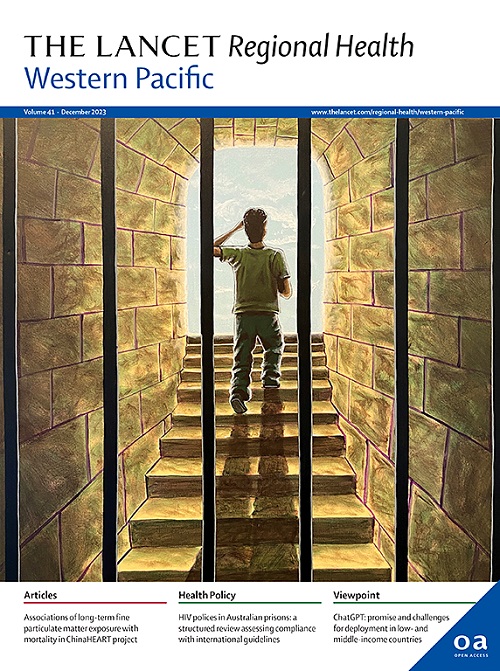Early intensive blood pressure management after endovascular treatment in ischaemic stroke (IDENTIFY): a multicentre, open-label, blinded-endpoint, randomised controlled trial
IF 7.6
1区 医学
Q1 HEALTH CARE SCIENCES & SERVICES
引用次数: 0
Abstract
Background
The optimal blood pressure (BP) management following successful endovascular treatment (EVT) in acute ischaemic stroke (AIS) patients remains unclear. This study investigated the safety and efficacy of intensive BP control in AIS patients who had received EVT within 6 h.
Methods
This randomised, multicentre, open-label, blinded-endpoint clinical trial (ChiCTR2200057770) was conducted at 63 stroke centres in China. Eligible participants had AIS due to large vessel occlusion in anterior circulation, underwent EVT within 6 h, and achieved successful recanalisation. Patients were randomised to intensive (systolic BP target <130 mm Hg) or standard (systolic BP target <180 mm Hg) management, maintained until 24 h post-EVT. The primary outcome was unfavourable functional outcome (modified Rankin Scale score of 3–6) at 90 days. The trial was terminated following a neutral interim analysis results and publication of counterpart randomised trials.
Findings
Between October 14, 2022 and March 18, 2024, 383 patients were randomised. Unfavourable functional outcome occurred in 71.0% (130/183) of the intensive-management group and 67.5% (135/200) of the standard-management group (risk ratio, 1.05; 95% CI, 0.92–1.20; p = 0.45). There was no significant difference in symptomatic intracerebral haemorrhage, malignant brain oedema, or all-cause death at 90 days.
Interpretation
Intensive BP management to <130 mm Hg did not improve outcomes in AIS patients undergoing EVT within 6 h and achieved successful recanalisation. The optimal BP management strategies require further investigation.
Funding
Sichuan University West China Hospital, National Natural Science Foundation of China, National Key R&D Programme of China, and Science and Technology Department of Sichuan Province.
缺血性卒中血管内治疗后早期强化血压管理(IDENTIFY):一项多中心、开放标签、盲终点、随机对照试验
背景:急性缺血性卒中(AIS)患者血管内治疗(EVT)成功后的最佳血压(BP)管理尚不清楚。本研究探讨了在6小时内接受EVT治疗的AIS患者强化血压控制的安全性和有效性。方法该随机、多中心、开放标签、盲终点临床试验(ChiCTR2200057770)在中国63个卒中中心进行。符合条件的参与者因前循环大血管闭塞而患有AIS,在6小时内行EVT,并成功再通。患者被随机分为强化(收缩压目标<;130毫米汞柱)或标准(收缩压目标<;180毫米汞柱)管理,维持到evt后24小时。第90天的主要结局是不良的功能结局(改良Rankin量表评分为3-6)。在中立的中期分析结果和相应随机试验的发表后,该试验终止。在2022年10月14日至2024年3月18日期间,383名患者被随机分组。71.0%(130/183)的强化管理组和67.5%(135/200)的标准管理组出现不良功能结局(风险比1.05;95% ci, 0.92-1.20;P = 0.45)。90天的症状性脑出血、恶性脑水肿或全因死亡无显著差异。解释:强化血压管理至130毫米汞柱,并没有改善6小时内接受EVT的AIS患者的预后,并实现了成功的再通。最佳BP管理策略有待进一步研究。资助项目:四川大学华西医院,国家自然科学基金,国家重点研发计划,四川省科技厅
本文章由计算机程序翻译,如有差异,请以英文原文为准。
求助全文
约1分钟内获得全文
求助全文
来源期刊

The Lancet Regional Health: Western Pacific
Medicine-Pediatrics, Perinatology and Child Health
CiteScore
8.80
自引率
2.80%
发文量
305
审稿时长
11 weeks
期刊介绍:
The Lancet Regional Health – Western Pacific, a gold open access journal, is an integral part of The Lancet's global initiative advocating for healthcare quality and access worldwide. It aims to advance clinical practice and health policy in the Western Pacific region, contributing to enhanced health outcomes. The journal publishes high-quality original research shedding light on clinical practice and health policy in the region. It also includes reviews, commentaries, and opinion pieces covering diverse regional health topics, such as infectious diseases, non-communicable diseases, child and adolescent health, maternal and reproductive health, aging health, mental health, the health workforce and systems, and health policy.
 求助内容:
求助内容: 应助结果提醒方式:
应助结果提醒方式:


